Principles of Object Oriented Programming with Java
Rather than preaching a particular methodology, this text helps readers crystallize their ideas about and upgrade their skills in design. Instructions show programmers how to put together what they... This description may be from another edition of this product.
Format:Paperback
Language:English
ISBN:1566045304
ISBN13:9781566045308
Release Date:January 1830
Publisher:Ventana Communications Group
Length:400 Pages
Weight:1.65 lbs.
Dimensions:1.2" x 9.2" x 9.2"
Customer Reviews
5 ratings
Well worth the money
Published by Thriftbooks.com User , 25 years ago
I thought this was an excellent book. It gives a very clear and concise introduction to java and OO programming. The chapter on The Fourier Transform is a bit misguided. Why is that here? I can only guess that the author was trying to give real world examples, but it's a bit too esoteric for most people, I suspect. I particularly like the way the author has taken the trouble to introduce the concept of design patterns, which are not java specific but which are of use to people using an OO approach in any language. This is a concept which is usually introduced in 'advanced' OO training courses. I was familiar with some of the patterns from using them in C++ but the author does an excellent job of explaining what they do and how they work and why to use them. But watch out: one or two of the examples given in the book don't seem to quite work correctly as they are given in the text, which caused me a bit of frustration.
The Best OOP for Java book I've read so far
Published by Thriftbooks.com User , 25 years ago
This book gives a thorough treatment of OO concepts and how they can be implemented in Java. It's a good intro to the language as well, and is example-based in its coverage of concepts. After becoming frustrated with various reference books, I decided to look carefully for a book that would teach solid principles of OOP and also provide immediate experience in writing useful programs in Java. This book distinguishes itself by going above and beyond those requirements. The introduction to the emerging area of design patterns was inspirational. However, the book omitted treatment of Threads and Networking in favor of "miscellaneous" topics like RMI and JDBC, and particular applications that illustrate the principles of design patterns like Fast Fourier Transform and printing. Not a complete reference, but as an introduction to some very important software design concepts it cannot be beat by other books that try to cover the entire language.
This book doesn't assume you know about OO design!
Published by Thriftbooks.com User , 25 years ago
90% of the books I've seen that claim to teach you Java, either assume you already understand object oriented design, or they teach you to write procedural Java (YUK!).After 15 years of procedural programming, I found the syntax of Java very straight forward, but I fell flat with other Java books because they all assume that the reader understands OO!James Cooper shows the various design strategies in good OO design, and then implements them in Java. I now understand how to "think OO".He also covers printing from Java in a very clear, concise way. This is a subject most authors avoid like the plague.
Very useful, very practical, concrete examples
Published by Thriftbooks.com User , 26 years ago
After years of trying to find out how software with indexing and database-handling are programmed, Cooper's book finally lets me see the light in just one chapter: "Arrays & String Classes in Java" -- in it he explains what to do when you want to create arrays but you don't know beforehand how many there are (Vectors), how to extract substrings from within strings surrounded by special characters (StringTokenizer), and how to create dynamic searchable indexes (Hashtable). And I actually understood what he was saying (very user-friendly examples). As an intermediate programmer, this book is a big step to mastery. Superb! On page 46 though, the code in the Hashtable example should be "hash.put("fred", new Person("fred"));" and not "hash.add(..."
My favorite Java book
Published by Thriftbooks.com User , 26 years ago
Even though the title emphasizes object-orientation as if Java were barely mentioned, the book is about 50% Java orientation. But it approaches Java from the perspective of good Object-oriented design. In fact, three chapters are devoted to OO design patterns. This book also contains the best treatment of Java printing that I've seen. If you have already programmed in another language and want a good dose of OO with your Java, I think you'll like this book.





